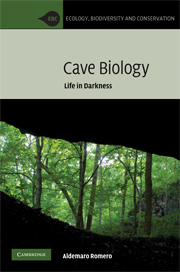Book contents
- Frontmatter
- Contents
- Preface
- Acknowledgments
- 1 A brief history of cave biology
- 2 Cave biodiversity
- 3 The evolutionary biology of cave organisms
- 4 The ecology of cave organisms
- 5 Cave conservation and management
- 6 Epilogue
- Appendix 1 Glossary of terms frequently used in biospeleology
- References
- Index
- Plate section
4 - The ecology of cave organisms
Published online by Cambridge University Press: 21 October 2009
- Frontmatter
- Contents
- Preface
- Acknowledgments
- 1 A brief history of cave biology
- 2 Cave biodiversity
- 3 The evolutionary biology of cave organisms
- 4 The ecology of cave organisms
- 5 Cave conservation and management
- 6 Epilogue
- Appendix 1 Glossary of terms frequently used in biospeleology
- References
- Index
- Plate section
Summary
This chapter is aimed at explaining the diversity of caves from an ecological viewpoint and the interactions among the different abiotic and biotic components of the hypogean environment. Particular emphasis is given to the ecological differences between caves in temperate and tropical environments, as most assumptions on cave ecology have been made based on caves in higher latitudes. These differences are also important because of their consequences in practical applications toward conservation issues.
Introduction
The first thing to be realized about the hypogean environment is that it is not a closed system. Not only do many cave creatures move in and out of this environment, but abiotic elements such as water, air, and many chemicals constantly flow through these ecosystems as well. Thus, to better understand how caves work from an ecological viewpoint it is necessary to look at them in a holistic way that includes the external ecosystems with which they interact.
The hypogean environment can be classified, for the purposes of this book, into three major classes: air, water-filled, and mixed. Sometimes the amounts of water can vary greatly, particularly in tropical areas, due to extreme variations of precipitation. Although many organisms live among the interstices of the soil particles, they are outside the scope of this book and are not considered directly in any depth. That does not mean that they are totally ignored, as mentioned in Chapters 2 and 3, since interstitial organisms sometimes represent transitional forms between epigean and hypogean environments.
- Type
- Chapter
- Information
- Cave BiologyLife in Darkness, pp. 159 - 181Publisher: Cambridge University PressPrint publication year: 2009
- 1
- Cited by



